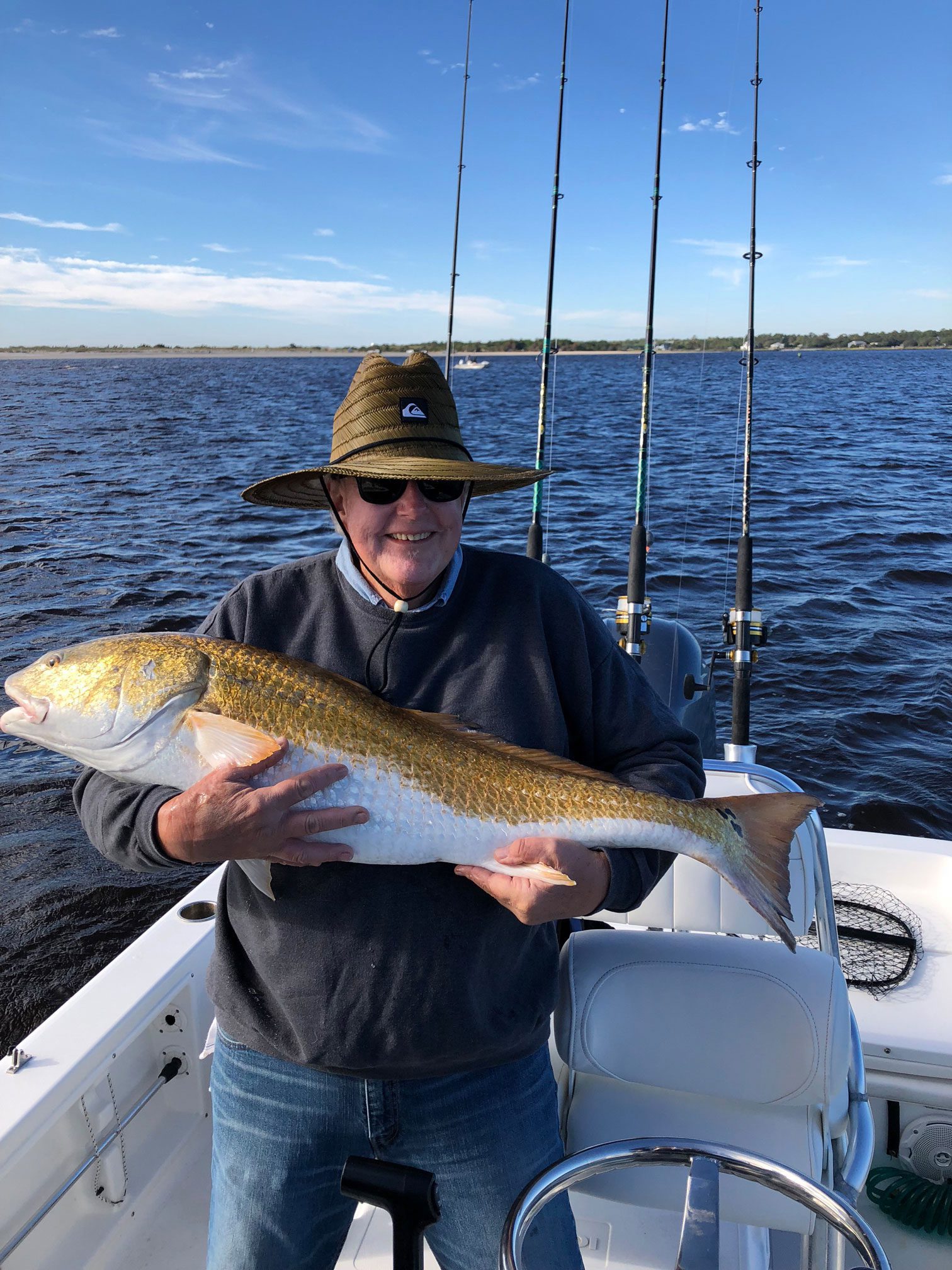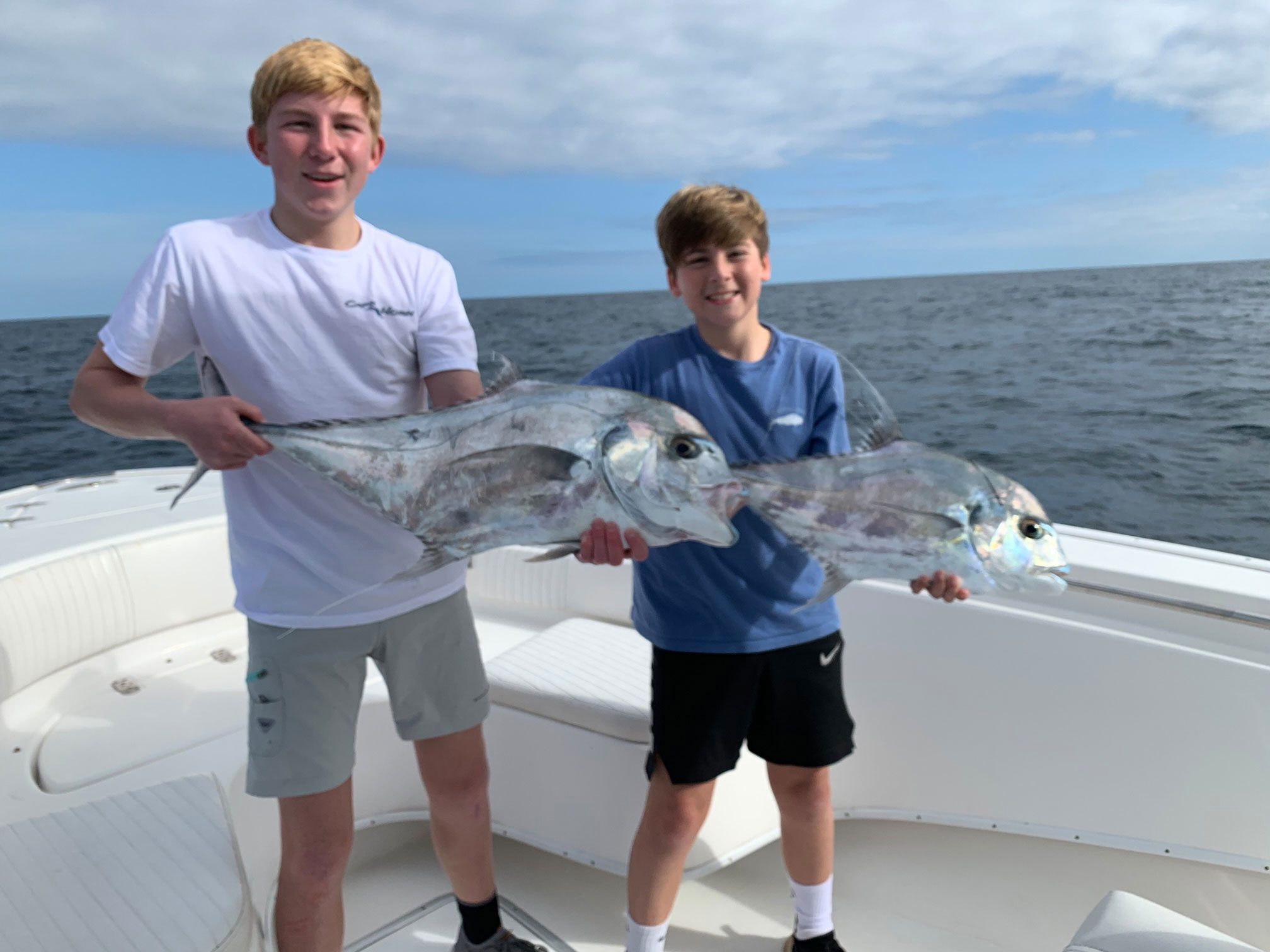Carolina Beach – March 21, 2019
Charlie, of Island Tackle and Hardware, reports that drum have been showing up in the rivers, where anglers can chase them with mud minnows or soft plastics (such as a Z-Man) on a jig head dropped to the bottom. Whiting have been chasing shrimp down at the mouth of the river, and while a few spots have showed up inside, the bite is definitely hit or miss.
Puffers have been caught on the beach by anglers using shrimp and sand fleas.
Wahoo in the 60-70 lb. range are being caught around the Steeples, Nipple, and the Same Ole hole.

Charlie Loops with an over-slot red drum that fell for a piece of cut mullet during the rising tide in Carolina Beach Inlet.
Christian, of Seahawk Inshore Fishing Charters, reports that a few reds and a few trout are coming in. Some of the reds can be found around dock pilings on the falling tide, where they’re hitting scented soft plastics and dead shrimp or mud minnows on the bottom. The trout have preferred small soft plastics and twitch baits, such as YoZuri crystal minnows.
Luke, of Spot On Charters, reports that excessive rain this winter has led to poor water conditions in the Cape Fear River. While the dirty water is slowly starting to filter out, it is still the dirty tea color that makes fishing difficult. With that being said, the water temperature is right and there are good numbers of bait around, so once the clarity catches up, the trout bite should be on fire. There have been no signs of a big fish kill like in years past.
Red drum action can be generated, but mostly to the south at Buzzard’s Bay or north to the Wrightsville Beach and Lee’s Island areas. Both spots are holding big schools of red drum, where small soft baits will do the most damage.

Jack and James Senhauser, from Charlotte, NC, caught this pair of African pompano while trolling a diving plug and dead cigar minnow around Frying Pan Tower.
Luke, of Coastline Charters, reports that there has been plenty of small finger mullet in the backs of the creeks with the warm water. As the tide falls out, the bait becomes much easier to find. There are also some small menhaden showing up in the creeks and boat basins. This will only get better in the days and weeks to come.
There have been great numbers of red and black drum hanging around docks on the ICW. Fresh Carolina-rigged shrimp are very hard for them to turn down, though soft plastics such as Z-Man EZ ShrimpZ on a white Blue Water Candy jig head have been working as well. Make sure to use light fluorocarbon leaders this time of year because of the clear water.
The drum bite should stay consistent for another few weeks until the water temperatures warm up and the schools of drum break up and begin to go into their summer pattern.
A good number of reds, in addition to speckled trout and a few flounder, have also been in area creeks (the closer to the inlets, the better). Focusing on deep holes and points with oyster rocks has been productive, where the same Z-Man/Blue Water Candy combo will turn heads, in addition to using shrimp or swim baits.
There have been decent numbers of sheepshead and a few drum hanging around the Masonboro jetty. Fresh shrimp on a Carolina rig will get them to bite.
Plenty of small bait can be found in the ocean, and with the water as warm as it is, the first run of false albacore and Atlantic bonito should be coming through soon.
Rod, of OnMyWay Fishing Charters, reports that an excellent king mackerel bite can be found where the water has been 68 degrees and above, such as around the Tower area. Fast-trolling Drone spoons, Sea Witches with belly strips, or pin-rigged ballyhoo should attract bites, as will slow-trolling frozen cigar minnows or small ballyhoo. Most of the kings have been between 8-12 lbs. (best for eating), though fish anywhere between 5-30 lbs. have been caught.
A fun trip can be had by anglers limiting out on kings at the Tower, then moving over to nearby live bottom and taking advantage of an exceptional black sea bass bite. Most of the sea bass can be found between 18-25 miles, and on the other side of the 25 mile mark, plenty of beeliners, pink snapper, and triggerfish are waiting to fill boxes.
There has been an epic wahoo bite at the break all throughout the winter, with the best catches being made in 69-73 degrees of water at depths of 130-170’. The typical spread of ballyhoo on wire leaders has been working, with the planer rods seeing the most action. Vertical jigging in 130-200’ of water has been fairly productive when targeting amberjack, blackfin tuna, and African pompano. Rock piles and rocky live bottom are the best places to look.
The Gulf Stream has been at 600’ of water or deeper, where good mahi fishing has been found all throughout the month of March. As the spring rolls in, the edge of the Stream should move closer to our break in the 170-250’ range, and the yellow brick road of mahi will be running through the area.
Once April hits, fishing will be phenomenal from the beach out to the Gulf Stream. Atlantic bonito will move in close when the water hits the 60-62 range, and when it hits 65, there will be a brief period of time that spanish mackerel will be mixed in with them. The best way to target the bonito is to use a run-and-gun method; when you see surface activity, quickly move to the school and either use casting jigs or troll Clarkspoons off #1 planers like you would for spanish.
Paul, of Kure Beach Pier, reports that while the pier is not open to fishing until the 29th, anglers fishing around the pier have been pulling in puffers and sea mullet.
